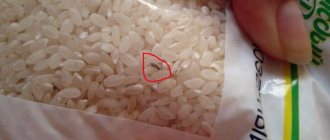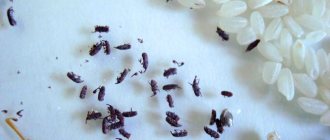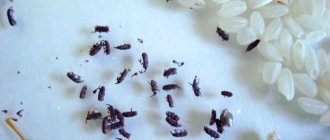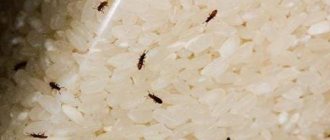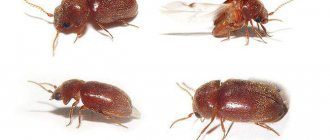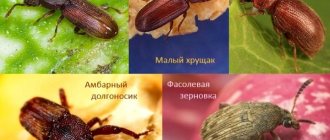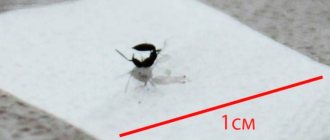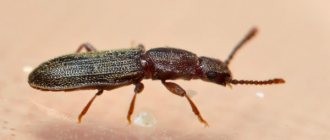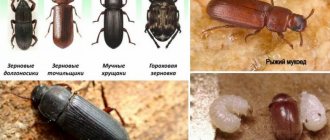Why can bugs appear in flour or cereals?
Beetles appear in cereals or flour, as well as in nuts, dried fruits, beans, peas and even tea, not because of the untidiness of the housewife or uncleanliness in the kitchen cabinet, if they were not there before. Bugs appear from outside.
From a pack bought in a store, from cereal taken from a neighbor or relatives, from dried fruits brought as a treat that were already infested with bugs.
This photo shows that the bugs that are in the cereal are not always easy to see!
Why do cereals get bugs? The reason is unscrupulous checks at enterprises when packing cereals and flour, and poor initial processing of grain. Grain must be processed in a special way before becoming cereal in order to exclude the possibility of the presence of living organisms and their larvae in it.
Another reason is the poor quality of work of the control bodies monitoring the quality of products. Any low-quality, contaminated batch of cereal or flour must be rejected and not allowed for sale.
Otherwise, bugs appear in flour or cereals, and people have to think about how to get rid of them.
How dangerous is contaminated food?
Is it possible to eat food in which pests have left their traces? A very interesting question, since many housewives try to immediately throw away such food products. Some still try to wash the affected products so that they can then prepare some kind of dish from them. In fact, it’s disgusting to even look at such a product, not even to eat it. Many experts still do not recommend eating porridge prepared with spoiled food. No matter how the cereals are washed, traces of pest activity may still remain on them. Eating contaminated foods can lead to:
- To allergic reactions. Children are especially defenseless.
- To food poisoning. The waste products of beetles negatively affect the functioning of the human digestive tract, which can cause diarrhea or vomiting.
If you take a special sieve and sift the flour, you can easily get rid of the waste products of parasites. After this, it is better to heat the flour in the oven at a temperature of about 50 degrees.
What insects can live in cereals and flour?
What to do if there are bugs in cereals or flour? To know how to get rid of bugs in cereals and flour, you need to know who exactly you need to fight.
Most often, flour beetles and food moths are found in cereals and flour.
The Surinam mucoedis is an insect of the order Coleoptera, a brown pest. It lives in granaries, mills, shops, houses and apartments.
In its development, the mucoed goes through several stages: egg, larva, pupa, and adult. The larva is very small in size - no more than 0.9 mm, so it is very difficult to detect. The mukoed lives from 0.5 to 3 years, laying up to 600 eggs.
Under favorable conditions (air temperature 25-27 degrees and humidity about 65%), the insect reproduces 2-3 times faster than at lower temperatures and humidity.
The Indian food moth is a small butterfly, up to 1 cm long. It lives only 2-3 weeks, but during this time it manages to lay up to 400 eggs, which then become caterpillars. The latter spoil the food by eating everything that is nearby.
After a few weeks, the grown larvae become pupae, and these, in turn, become adult butterflies, ready to produce new offspring.
Both flour eaters and moths are very tenacious, even in frost they do not die immediately. This must be taken into account in order to understand how to get rid of bugs in flour and cereals.
The photo below shows another type of bug that can be found in cereals or flour in your kitchen - this is the flour beetle:
Is it possible to eat cereals or flour if there are bugs in it?
One of the most common questions that arises among people who encounter insects in the kitchen: if there are bugs in the cereal, can it be eaten? Seeing that there are insects in cereals or flour, it is unlikely that anyone will want to eat them. But if we ignore the psychological component, is it possible to sort out the cereal, wash it and be sure that there are no bugs?
The answer to this question is negative. The fact is that even if you sort through the cereal and remove all the bugs, the larvae may simply not be noticed. They are small and have an inconspicuous color.
In addition, the cereal contains waste products of bugs, caterpillars and larvae: feces, dead larvae, husks that remain during degeneration into a pupa or butterfly.
The situation is somewhat different with flour. It can be sifted into a fine sieve, through which neither larvae nor debris left by bugs will pass. This is one way to get rid of bugs in flour.
After this operation, it is recommended to heat the sifted flour in the oven at 50 degrees.
Causes of flour bugs
The most common reason is non-compliance with technological and sanitary standards during food production. Therefore, no one is immune from such a nuisance.
Initially, insects enter the house with dry food, and then quickly spread throughout the kitchen. Pests colonize near food, but are found in cracks, latches and other hidden places.
This is interesting: most insects are so small that they are difficult to notice with the naked eye. They camouflage themselves with the color and shape of the environment in which they live.
In everyday life, bugs appear in cereals or other products if:
- Containers for storing bulk solids are selected incorrectly. Preference should be given to glass and plastic containers with fully screw-on lids or a vacuum effect. An inexpensive alternative is to use plastic bags that must be tied. Limited contact with air and dampness allows you to preserve food longer and prevent insects from accessing it.
- The expiration date has expired. All food products have a specific shelf life. Information about this is indicated on the packaging. Goods sold by weight are fraught with danger, since the actual date of their production and sorting cannot be determined.
- Conditions of detention are not met. A warm, damp atmosphere in a closet or indoors, if we are talking about a pantry, is a favorable factor for the intensive reproduction of cereal bugs. In this regard, air temperature and humidity play an important role when choosing a place to store bulk products.
Advice: it is recommended not to make large reserves unless absolutely necessary, but to limit yourself to moderate volumes and look into the bins more often.
Pest insects like to nest in:
- various cereals;
- pasta;
- flour;
- loose leaf tea;
- granulated or ground coffee;
- dried fruits;
- spices
In order to promptly notice the presence of an “inedible impurity” in a product, you need to know what exactly to look for, that is, what the bugs look like.
Important: the main danger lies not even in food spoilage, but in the allergic reaction or food poisoning that they can provoke.
How to get rid of insects in cereals and flour
Before you completely remove the bugs that have infested in cereals and cupboards, you need to throw away all the cereals in which they were found. Some people cook this cereal and feed it to backyard birds, which are not afraid of bugs; this is their daily food.
You cannot limit yourself to simply getting rid of contaminated products. After all, larvae can be on packages with other products that were lying nearby, on doors, and in the corners of cabinets.
The next thing you should definitely do when fighting bugs is to wash the cabinet with detergent and then treat it with vinegar. Banks in which spoiled cereals were stored must also be processed.
Traditional methods of fighting bugs
We free the room from insects using vinegar, boiling water, soda, salt and aromatic plants. As mentioned above, chemicals are not a very good assistant in controlling pests in the kitchen, so let’s look at traditional methods.
- We dismantle the kitchen units and cabinets in which food is stored. It’s better to throw away all opened packages, no matter how sorry it is. Even one remaining insect can give birth and you will have to start all over again.
- Take acetic acid of at least 8% and dilute it with lukewarm water. We wash cabinets and shelves lengthwise and crosswise, leaving not a single centimeter untreated. In addition to disinfection, vinegar also has a pungent odor that insects do not like.
- It is not recommended to store bulk products in cellophane or fabric bags. Take glass jars or plastic containers and pour hot water or salt solution over them.
- Salt and soda also fight pests well. We prepare the mixture and dilute it with water, and use the solution to clean the kitchen.
- Bugs do not like strong odors, so you can buy essential oils containing eucalyptus, lavender or mint at the pharmacy. Spray the fabric and place on the shelves along with the cereal. Insects will have less desire to settle in such a fragrant closet, but the fabric must be constantly changed as the smell fades.
Prevention of insects in flour and cereals
In order not to think about how to remove bugs from cereals or flour, you can take some measures that will prevent them from appearing and multiplying.
Pests cannot tolerate strong odors. Therefore, garlic, bay leaves, and cloves placed in cabinets will help prevent the appearance of bugs.
Another good way to keep flour and cereals from bugs is to store these products in glass, metal or plastic containers with tight-fitting lids.
What to put in cereals to prevent bugs from infesting them: remedies
Garlic and bay leaves can be placed in cereals to prevent bugs from infesting them.
Of course, the refrigerator is not exactly the place where cereals and flour will be stored constantly, it is inconvenient. Therefore, you can try to get rid of bugs using strong-smelling products. It was said above that in ancient times, women used such methods. Modern housewives also often resort to similar methods. What to put in cereal to keep bugs away? Here are the means:
- Bay leaf - this can be periodically rubbed between your palms to enhance the scent.
- Garlic - several cloves are placed in jars with bulk products, having previously cleared it of the covering husk. But there is no need to cut off the very top of the clove.
- Chamomile-pyrethrum powder (found at pharmacies). This plant is capable of expelling not only bugs, but also mice from the room.
- Dried marigold flowers - they need to be changed periodically so that the smell does not fade.
- The aroma of lavender is also good at repelling insects. It is necessary to place cotton pads or paper napkins soaked in lavender oil on the shelves in the closet.
- Powdered nutmeg will help you forget about pests in your kitchen cabinets for a while.
- Various metal objects help in getting rid of insects - nails (only large ones; small ones can be accidentally put into a pan with cereal), wire, new metal lids for seaming.
Wrap jars where cereals and flour are stored with foil. This method may seem strange, as with metal objects, but it is effective.
Why do bugs appear in cereals?
Many people believe that kitchen pests arise only as a result of gross violations of sanitation and hygiene standards. Unfortunately, it is not. Flour bugs can live in your food, even if you regularly do thorough wet cleaning. The main reason for the appearance of parasites is non-compliance with control standards at food production enterprises. Some manufacturers ignore even such a mandatory procedure as heat treatment, not to mention high storage standards.
You can detect black bugs in cereals even if you purchased the product in vacuum packaging. Insects usually have plenty of time to “invade” while the product is awaiting packaging. Bugs in the kitchen do not limit their stay to one “house”. They quickly and willingly master new nutrient environments, while not forgetting about future generations. Parasites reproduce very quickly and fruitfully. The answer to the question of how to get rid of insects in cereals and in the cupboard will be incomplete if it does not contain information on how to find and destroy egg-laying insects. And they can be located almost anywhere, including the most inconspicuous crevices in furniture. Fortunately, this problem can usually be dealt with without the help of strong chemicals.
Bugs in the kitchen: varieties
Before we move on to discussing the question of how to get rid of cereal bugs in the kitchen, let's take a closer look at the “opponents”. Insects, whose vital needs so unfortunately coincided with our interests, belong to one of the following varieties:
- flour beetles;
- bread grinders;
- food moth;
- red mucoeds.
The most widespread parasites are the first type. These are small brown individuals, the length of which does not exceed 4 mm. A small flour bug usually gets into the home along with a bag of starch or some kind of powder mixture. Once in the closet, the hruschaks immediately begin to look for new habitats. If there is a loosely closed container with other bulk products nearby, the flour beetle will definitely “master” it. Cereals, rice, dried fruits and buckwheat are also at risk, although these pests are much less interested in them.
Naturally, the longer the little black bugs in the kitchen go unnoticed, the more food will be destroyed. Khrushchaki reproduce very quickly, laying their eggs in a variety of places. Newborn larvae immediately begin to invade nearby “deposits”. We will tell you below how to deal with bugs in cereals and flour.
Other types of harmful insects are much less common. The mole is easy to spot. Its adults can reach 10 cm in length. Outwardly, these cereal beetles resemble silver butterflies. Such “guests” enter the apartment through ventilation and windows. The object of their attention is products stored in the public domain.
Bread grinders and flour eaters prefer to settle in industrial enterprises. When it comes to these insects, the problem of how to get rid of insects in cereals concerns more the personnel of the above organizations. However, unfortunately, ordinary citizens also have to deal with them. Grinders are small flying white bugs in the kitchen that can measure up to 3mm. Their target is usually bread and flour products: biscuits, cookies, etc. In this regard, they pose the greatest danger to bakeries and flour mills. Grinders enter residential buildings through bags of food or animal feed. In addition to bakery products, these food bugs happily consume coffee, tea, dry plants, animal feed and even book bindings. So if they happen to be your guest, it's not just your kitchen cabinets that may need a major cleaning.
How to get rid of flour eater is also a relevant question mainly for owners of food enterprises. These miniature red insects can only feed on rotten grain or flour. If the humidity of the product is below 15%, it is not in danger. How to get rid of mucoed in an apartment? Very simple. You just need to throw away substandard food in a timely manner. The main danger lies in cheap animal feed. If you take the choice of food for your pet with sufficient responsibility, then these small bugs will never appear in the kitchen. If trouble happens, you have no choice but to act according to the scheme described below.
If there are bugs in the flour, can it be used?
Many thrifty owners are interested in what to do if there are bugs in the rice. Is it possible to eat it or is it better to immediately throw it away out of harm’s way? Ideally, spoiled products should be disposed of. Elementary disgust has not yet been abolished, in addition, even a mass thoroughly cleaned of adult individuals may contain the remnants of their vital activity. It’s not enough to get the beetles out of the grains; you also need to be sure that the cleaning was perfect. Even if you calmly accept the fact that parasites are in your food, this will not save you in case of poisoning. The consequences may be the most tragic.
If you are thinking about how to get rid of bugs in the kitchen and at the same time do not want to throw away spoiled food entirely, the processing should be as thorough as possible. In the case of flour, you will need a sieve with the smallest mesh possible. Not only adults should remain on the grill, but also the larvae and debris they produce. However, it is not enough to simply remove insects in flour in the kitchen. To gain complete confidence in the safety of purified food, it must be subjected to thorough heat treatment. There are two ways to influence insects with temperature. You can finally get rid of the flour bug by placing the sifted mixture in the oven. Drying at a temperature of fifty degrees will not leave any chance for harmful residues. Another option is to freeze. A day in the freezer will also destroy all germs.
What to do if insects are found in cereals? How to get rid of them without throwing away the entire product. In such situations, the cleaning process is even easier. Simply pour salt water over the rice, beans or beans and leave for a few minutes. After some time, all the bugs in the cereal will separate from the main mass and float up, as well as their derivatives. After this, all that remains is to carefully drain the water and dry everything on a clean cloth. Once you get rid of flour bugs, use the products as soon as possible. Some of the taste will be lost, but the nutritional properties will remain at an acceptable level.
Restorative actions make sense only when only a small part of the main mass is affected. If insects in cereals or flour have left behind an impressive “web” of yellow worms, you should come to terms with the loss and do everything to ensure that a similar situation does not happen again. Spoiled food should be thrown away along with its container. The bag or sack is carefully packed in sealed cellophane and only then taken out of the house.
Types of kitchen parasites
The following pests can appear in the kitchen:
- Bread borer - small (length - 3 mm) light brown insects. They are attracted to book bindings, crushed grain mixtures, coffee, dried herbs, tea, animal feed and dried bakery products (crackers, crackers, cookies, biscuits). The bread grinder flies well - it can fly into a window, guided by the light. But most often, bugs enter the house along with store-bought food and animal feed;
- Weevils are small dark brown or black bugs with a long proboscis. Under favorable conditions, they produce offspring up to 6 times a year. Most often they can be seen in packages with buckwheat, pasta, rice, flour and legumes;
- The flour bug is a small insect (4 mm long) with a red-brown body. These pests are brought into the house along with flour and starch. The flour bug easily penetrates into any container. They happily live in all types of flour, buckwheat, rice, semolina, dried fruits, and rolled oats. These insects reproduce incredibly quickly. Eggs are laid not only in food, but also in the crevices of furniture, as well as in home textiles. Hatched individuals are able to crawl throughout the house in search of food;
How to get rid of the flour beetle, read more in this article.
- Food moth - the adult resembles a gray butterfly with a body 10 mm long. The reason for its appearance is inadequate processing and storage of food products. Moths can also fly into the kitchen through open windows. Most often it settles in packages of tea, pasta, cocoa and dried fruits. Infected products are covered with a thin cobweb; yellow worms appear in them;
- Red flour beetles are miniature bugs (length - 2.5 mm), the source of infection of which is low-quality grain food for pets. It is a frequent inhabitant of bakeries, mills, and factories. They like to eat grains, cereals and spoiled flour with a moisture content of more than 15%. Unable to find suitable food, the red mucous eater dies.
These photos will help you recognize these bugs.
Attention! If there is a strong infestation of bugs, the nutritional value of the food is reduced to zero. Together with insects, bacteria settle in them, which can lead to allergies and food poisoning.
How to get rid of bugs in cereals and in the kitchen cabinet
Having dealt with the products, they proceed to the next stage - the destruction of traces of insect activity. If this is not done, then the question of how to get rid of brown bugs in the kitchen will arise before you with unenviable regularity. Parasites lay their eggs in a variety of places, so their larvae can appear anywhere in the food cabinet.
To ensure that little brown bugs in the kitchen don’t have a chance, you need to thoroughly disinfect all shelves and containers located on them. The cabinet is completely emptied of bags and containers, after which all food debris (spilled flour, cereal, etc.) is carefully swept out. The latter need to be flushed down the toilet. Never be frugal. Even if there are no beetles in the flour, traces of their presence may remain.
The shelves are wiped with a vinegar solution. One tablespoon of vinegar for a liter of water is enough. When there are bugs in your kitchen cabinet, getting rid of them is not so easy. They leave eggs in almost imperceptible crevices, so heat treatment will also be required. All places where there is even the slightest suspicion of holes should be poured with boiling water. During the procedure called “fighting beetles in cereals”, it is necessary to pay sufficient attention to the containers used to store products. The jars are thoroughly washed with laundry soap and then doused with boiling water. Bags and bags made of fabric are treated with saline solution. Once they dry out, the beetles in the rice will definitely not be able to lay eggs. There is no need to rinse the material.
If you are not sure that you have managed to finally get rid of black bugs in the kitchen, you can use folk remedies. The first method is to use homemade bait. Mix fine grains with powdered sugar and brown sugar in equal proportions. The resulting composition is laid out on paper sheets and placed on shelves. This mixture is completely safe for us, but it really helps to get rid of bugs in the kitchen in cereals and flour.
The second option is to purchase pyrethrum at the pharmacy, made from chamomile (Persian, Caucasian). You can simply sprinkle the powder on the shelves or pour it into linen bags. This very effective remedy for bugs in cereals also does not pose any threat to human health.
Chemistry
It is quite natural that when thinking about how to get rid of insects in cereals, the possibility of using chemicals is considered last. Moreover, as a rule, it is possible to cope with the problem with “clean” means. But if the measures described above do not bring results, the following drugs can help get rid of midges in cereals:
What to do if there are bugs in the kitchen and your financial options are limited? Chalk "Mashenka" costs 5-6 times cheaper than the next most affordable "Karbofos". To repel insects, you only need to coat the inside corners of the cabinets. Antizhuk is the most expensive, but it has the highest efficiency on this list. The advantage of Karbofos is the variety of forms: tablets, aerosol, powder, liquid. If you decide to get rid of bugs in cereals and flour in the kitchen using chemicals, carefully follow the instructions. It is important that the treated areas are inaccessible to animals. The poison, designed for small parasites, is poison for both dogs and cats.
How to remove insects from kitchen furniture?
If there are bugs not only in food, but also in furniture in the kitchen, you need to urgently take measures that will allow you to get rid of not only adult individuals, but also larvae and clutches of eggs.
Step 1. Empty all cabinets of boxes and bags of cereals.
Step 2. Immediately flush any spilled food down the toilet - it may contain parasite eggs.
Step 3. Wipe the surfaces with water and vinegar (1 tbsp per 1 liter of water).
Step 4. All holes and cracks must be filled with boiling water.
Step 5. Wash jars for storing flour and cereals with soap and rinse with very hot water.
Step 6. Wash textile bags in saline solution and dry without rinsing. After this treatment, the bugs will no longer be able to lay eggs.
Step 7. Pyrethrum (Persian chamomile powder), a natural insecticide that allows you to fight household pests without harming your own health, will also help remove insects. It is scattered inside cabinets or poured into fabric bags. Repeat treatment once every 1.5 weeks.
Step 8. You can use bait to lure kitchen bugs out of secluded crevices. There are several recipes for their preparation.
Recipe 1. Mix powdered sugar, borax and fine grains. Place a small amount of the mixture on sheets of paper and place them around the kitchen.
Recipe 2. Combine powdered sugar with borax and millet, crushed in a coffee grinder (take everything in equal quantities). Roll small balls, dry them slightly and place them in cabinets.
Recipe 3. Mix sugar, borax and dry yeast. Pour the composition onto pieces of paper and place on the shelf.
Step 9. The best remedies for food moths are lavender and wormwood. You can use both the plant itself and essential oil. In the first case, small bouquets are made from fresh or dried twigs, in the second, a piece of cotton wool is soaked in essential oil. Anti-bug esters also include basil, geranium, cloves, fir and rosemary.
Step 10. Most beetles are afraid of sunlight. When you come home from the store, pour the cereal into glass jars without lids and place them on the windowsill.
Interesting! Most often, parasite larvae infect goods sold by weight on street stalls. Refrain from such purchases in favor of packaged groceries.
Prevention
If there are bugs in the cereal, getting rid of them is not so difficult, but it will require some time and effort. In addition, you will have to say goodbye to at least part of the product affected by insects. The best way to deal with parasites is not to give them a single chance to “populate”. Keep your cupboards and kitchen counter tidy, and store food supplies in airtight containers. Check regularly for cereal bugs. Getting rid of the problem at an early stage is much easier and less expensive. The more supplies you have at home, the more often you need to audit.
If you don’t want to think about where the bugs got into the flour and what to do with them, don’t neglect prevention. One of the means to prevent the appearance of harmful insects is the use of strong odors. Bay leaves, garlic and cloves on the shelves will become quite a serious barrier for parasites. Bugs will not appear in flour if it is stored in a glass or plastic container with an airtight lid. The main thing is that the product is clean from the beginning.
We have already mentioned why bugs most often appear in cereals. What can you do to eliminate the possibility of bringing home low-quality food? Firstly, try not to purchase dubious goods on the cheap. Secondly, new products should be subjected to heat treatment. Staying in the freezer will completely kill the bugs in flour and cereals. Science has not yet figured out how to get rid of possible larvae in another way. Note that parasites can also live in tea, cocoa, pasta and dried fruits. Finally, let us express our hope that your peace will never be disturbed by bugs in your cereal. You already know how to get rid of them in the kitchen, but not all knowledge needs practical testing. You can get more detailed information on important everyday issues on the website of our company in Moscow.
What types of bugs are found?
Tiny pests can live in the kitchen:
- Surinamese mucoeds.
Suriname mucoed
These exotically named beetles love cereals and thrive in them. Females of these insects often breed in warehouses. Tiny eggs cannot be seen by humans with the naked eye. Adult beetles and larvae can enter living spaces in bags of bulk foods such as cereals, pasta and rice. However, the Surinamese flour eater (its maximum length is 2 millimeters) loves not only cereals. It can spoil nuts, crackers, concentrates, dried fruits, dried fruits, and cookies.
- Flour beetle. This is the name given to a small beetle with a maximum body length of 4 millimeters. These insects in the kitchen settle in bags containing cereals, kitchen containers for bread, and cabinets.
flour beetle
They have an orange color, which is clearly visible on light-colored surfaces. They feed on flour from wheat and rye, as well as semolina, rice and other cereals.
- Grinder. These parasites, often found in the kitchen, have oval-shaped heads. The maximum length is 3 millimeters. These insects in cereals have a color ranging from dark yellow to brown. They easily gnaw their way through floors, doors, and window sills. Found in flour, cereals, they also love nuts, dried fruits, and cookies. In addition, they often eat wood, sweets, and pasta.
Grinder
- Food moth. This pest also often lives in flour. It does not belong to beetles, but to Lepidoptera, essentially being a tiny butterfly.
food moth

